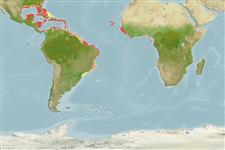>
Mulliformes (Goatfishes) >
Mullidae (Goatfishes)
Etymology: Mulloidichthys: Latin, mullus = soft + Greek, ichthys = fish (Ref. 45335).
More on author: Cuvier.
Environment: milieu / climate zone / depth range / distribution range
Ecologia
marinhas associadas(os) a recifes; intervalo de profundidade 0 - 49 m (Ref. 9710), usually 0 - 35 m (Ref. 40849). Subtropical; 33°N - 26°S, 98°W - 8°E
Western Atlantic: Bermuda and Florida, USA to Brazil, including the Gulf of Mexico and the Caribbean Sea (Ref. 9626). Eastern Atlantic: single record from Ile de Sào Tiago, Baie de Tarrafal, Cape Verde (Ref. 7313). Reported from São Tomé Island (Ref. 34088).
Comprimento de primeira maturação / Tamanho / Peso / Idade
Maturity: Lm 17.0 range ? - ? cm
Max length : 44.8 cm TL macho/indeterminado; (Ref. 104752); common length : 28.0 cm TL macho/indeterminado; (Ref. 3792)
Espinhos dorsais (total) : 9; Raios dorsais (total) : 8; Espinhos anais: 2; Raios anais : 6. Body pale tan with distinctive yellow stripe from eye to caudal fin; tail yellow. Less brightly colored than other species and is the only one with a single yellow stripe along side (Ref. 26938).
Found over sandy areas of lagoon and seaward reefs (Ref. 9710). Often in schools (Ref. 26938). Forms schools with the smallmouth grunt (Haemulon chrysargyreum), an association regarded as social protective mimicry (Ref. 52492). Juveniles are common in seagrass beds (Ref. 9710). Feeds on benthic invertebrates (Ref. 7313). Marketed fresh (Ref. 3792).
Ciclo de vida ou comportamento de acasalamento
Maturities | Reprodução | Spawnings | Egg(s) | Fecundities | Larvas
Robins, C.R. and G.C. Ray, 1986. A field guide to Atlantic coast fishes of North America. Houghton Mifflin Company, Boston, U.S.A. 354 p. (Ref. 7251)
Status na Lista Vermelha da UICN (Ref. 130435)
Ameaça para os humanos
Reports of ciguatera poisoning (Ref. 30303)
Uso pelos humanos
Pescarias: pouco comercial
Ferramentas
Relatórios especiais
Baixar XML
Fontes da internet
Estimates based on models
Preferred temperature (Ref.
123201): 23.4 - 28, mean 26.6 °C (based on 720 cells).
Índice de diversidade filogenética (Ref.
82804): PD
50 = 0.5078 [Uniqueness, from 0.5 = low to 2.0 = high].
Bayesian length-weight: a=0.01047 (0.00920 - 0.01192), b=3.10 (3.06 - 3.14), in cm total length, based on LWR estimates for this species (Ref.
93245).
Nível Trófico (Ref.
69278): 3.2 ±0.1 se; based on diet studies.
Resiliência (Ref.
120179): médio(a), tempo mínimo de duplicação da população 1,4 - 4,4 anos (Preliminary K or Fecundity.).
Fishing Vulnerability (Ref.
59153): Low to moderate vulnerability (35 of 100).
Nutrients (Ref.
124155): Calcium = 29.6 [13.3, 56.9] mg/100g; Iron = 0.508 [0.238, 0.895] mg/100g; Protein = 19.3 [17.5, 21.1] %; Omega3 = 0.218 [0.126, 0.415] g/100g; Selenium = 15.4 [8.0, 29.7] μg/100g; VitaminA = 47.6 [15.2, 179.0] μg/100g; Zinc = 0.768 [0.467, 1.155] mg/100g (wet weight);
